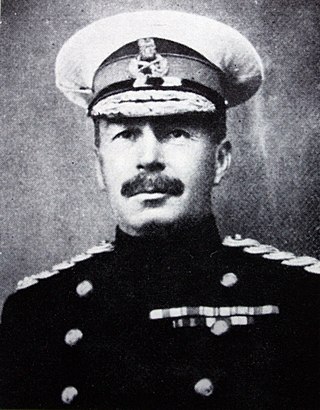
The Second Boer War, also known as the Boer War, Transvaal War, Anglo–Boer War, or South African War, was a conflict fought between the British Empire and the two Boer republics over the Empire's influence in Southern Africa.

The Solomon Mahlangu Regiment is a reserve infantry regiment of the South African Army.

The Cape Town Highlanders is a reserve mechanised infantry regiment of the South African Army.

The Durban Light Infantry is a Motorised Infantry regiment of the South African Army. It lost its status as a Mechanised infantry regiment in 2010 in line with the rationalisation of resources. As a reserve unit, it has a status roughly equivalent to that of a British Army Reserve or United States Army National Guard unit.

The Chief Langalibalele Rifles is a reserve infantry regiment of the South African Army.

The Autshumato Anti-Aircraft Regiment is a reserve air defence artillery regiment of the South African Army.
South Africa has a number of Traditional Regiments. These are mostly South African Army Reserve Force regiments that were established either under previous colonial governments or by the Apartheid regime and which have continued to exist by accepting the authority of the government-of-the-day - be it colonial, union, Apartheid, or fully democratic.
The Cape Colonial Forces (CCF) were the official defence organisation of the Cape Colony in South Africa. Established in 1855, they were taken over by the Union of South Africa in 1910, and disbanded when the Union Defence Forces were formed in 1912.

Major-General Sir Henry Timson Lukin was a South African military commander. He fought in the Anglo-Zulu War (1879) and the Basutoland Gun War (1880–1881), the Bechuanaland Campaign (1897), and the Anglo-Boer War when he was in command of the artillery during the defence of Wepener for which action he was awarded a Distinguished Service Order. From 1900 to 1901 he commanded the Cape Mounted Riflemen, from 1904 to 1912 he was Commandant-General of the Cape Colonial Forces and in 1912 Inspector-General of the Permanent Force of the Union of South Africa.

The Queen's South Africa Medal is a British campaign medal awarded to British and Colonial military personnel, and to civilians employed in an official capacity, who served in the Second Boer War in South Africa. Altogether twenty-six clasps were awarded, to indicate participation in particular actions and campaigns.

The King's South Africa Medal is a British campaign medal awarded to all British and Colonial military personnel who served in the Second Boer War in South Africa, and who were in the theatre on or after 1 January 1902 and who had completed 18 months service in the conflict prior to 1 June 1902.

The Pretoria Forts consists of four forts built by the government of the South African Republic (ZAR) just before the outbreak of the Second Anglo-Boer War around their capital of Pretoria.

Prince Alfred's Guard Memorial is a provincial heritage site in St George's Park in Port Elizabeth in South Africa's Eastern Cape province. The memorial is situated on top of Port Elizabeth's second oldest reservoir. On November 6, 1907 the Honourable Edgar H Walton, MLA, Treasurer General of the Cape Colony, unveiled the memorial to the fallen of the Prince Alfred's Guard.

The military history of Australia during the Boer War is complex, and includes a period of history in which the six formerly autonomous British Australian colonies federated to become the Commonwealth of Australia. At the outbreak of the Second Boer War, each of these separate colonies maintained their own, independent military forces, but by the cessation of hostilities, these six armies had come under a centralised command to form the Australian Army.

General Sir Bruce Meade Hamilton, was a British Army general during the Second Boer War and the First World War.
Norvalspont is a small town in Pixley ka Seme District Municipality in the Northern Cape province of South Africa. The name is Afrikaans for Norval’s ferry, and named after an enterprising Scot who constructed a ferry here in 1848. The settlement lies some 40 km east-north-east of Colesberg and 43 km west-north-west of Venterstad, on the southern bank of the Orange River, just below the Gariep Dam.

Bloemhof Commando was a light infantry regiment of the South African Army. It formed part of the South African Army Infantry Formation as well as the South African Territorial Reserve.

Major General Alexander Whitelaw Thorneycroft, was a senior British Army officer during the Second Boer War.

Heidelberg Commando was a light infantry regiment of the South African Army. It formed part of the South African Army Infantry Formation as well as the South African Territorial Reserve.

This is a list of blockhouses built by the British Empire in South Africa during the Second Anglo-Boer War from 1899–1901. Of the fortifications constructed during the war, around 441 were solid masonry blockhouses, many of which stand today. Different designs were used in the construction, but most were either two or three story structures built using locally quarried stone.





















